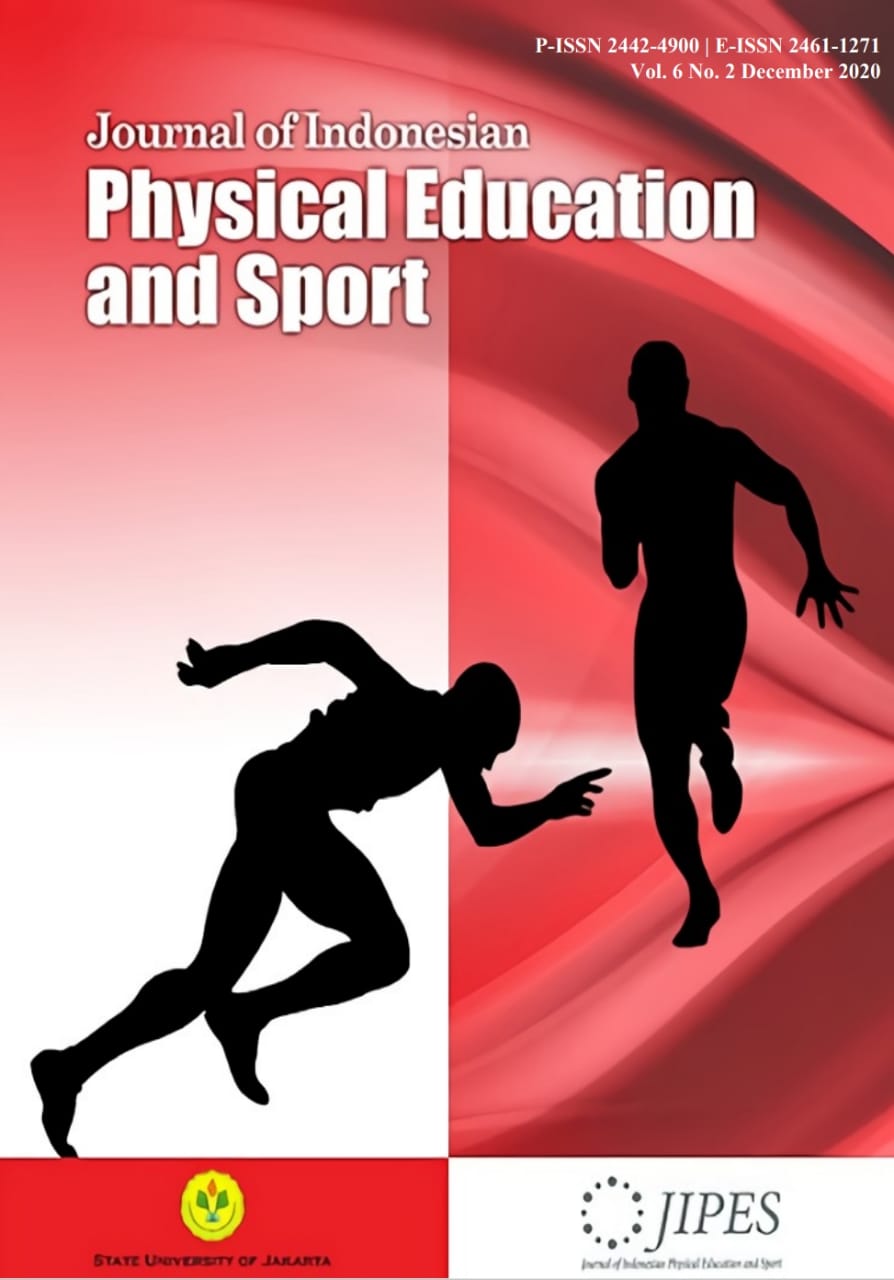THE EFFECTIVENESS OF PLAYING METHODS IN IMPROVING PHYSICAL EDUCATION LEARNING OUTCOMES (INDONESIA)
The Effectiveness of Playing Methods in Improving Physical Education Learning Outcomes
Abstract
This study aims to see the effectiveness of the playing methodin improving physical education learning outcomes. The playing method can be given to students in order to understand and explain the learning material. When using thethe playing method can introduce various levels of tasks / material to be carried out. Where the playing method assigns different tasks in levels. The use of the playing method can encourage students to determine their level of performance in carrying out the physical education learning process.This article providesincrease on physical education learning outcomes, with difference in mean = 7.06, which means the difference in learning outcomes scores physical education between after and before given the playing method. The positive price was significant after being given the play method with the physical education learning outcomes score higher than before the playing method was given. Furthermore, the results in this study are the statistical price t =20,276, where db = 43 and the number sig. or p-velue = 0.000 <0.05 or H0 is rejected. Thus, it can be concluded that the method of playing provides positive results on students' physical education learning outcomes. Because by playing students can develop creativity, physical, motor, perception, cognitive, and social personal.
References
Bjorklund, DF, & Brown, RD (1998). Physical play and cognitive development: Integrating activity, cognition, and education. Child Development. https://doi.org/10.1111/j.1467-8624.1998.tb06229.x
Burdette, HL, & Whitaker, RC (2005). Resurrecting Free Play in Young Children. Archives of Pediatrics & Adolescent Medicine. https://doi.org/10.1001/archpedi.159.1.46.
Burghardt, GM, 2011. Defining and recognizing play. In: Pellegrini, AD (Ed.), The Oxford Handbook of the Development of Play. Oxford University Press, New York, pp. 9–18.
Bishop, JC, Curtis, M., 2001.Introduction.In: Bishop, JC, Curtis, M. (Eds.), PlayTodayin the Primary Play School Ground. Open University Press, Buckingham, PH, pp. 37–57.
Baines, E., Blatchford, P., 2011. Children's games and playground activities in school and their role in development. In: Pellegrini, AD (Ed.), The Oxford Handbook of the Development of Play. Oxford University Press, New York, pp. 261–283.
Ellaway, A., Kirk, A., Macintyre, S., & Mutrie, N. (2007). Nowhere to play? The relationship between the location of outdoor play areas and deprivation in Glasgow. Health and Place. https://doi.org/10.1016/j.healthplace.2006.03.005.
Escalante, Y., Garcia-Hermoso, A., Back, K., Saavedra, JM, 2013. Playground design to increase physical activity levels during school recess. A systematic review. Health Education & Behavior, published online July 8.
Farley, TA, Meriwether, RA, Baker, ET, Rice, JC, & Webber, LS (2008). Where do the children play? The influence of playground equipment on physical activity of children in free play. Journal of Physical Activity and Health. https://doi.org/10.1123/jpah.5.2.319.
Karsten, L., 2003. Children 'use of public space: the gendered world of the play-ground. Childhood 10 (457).
Ntoumanis, N. (2001). A self-determination approach to the understanding of motivation in physical education. British Journal of Educational Psychology. https://doi.org/10.1348/000709901158497
Pellegrini, AD, & Smith, PK (1998). Physical activity play: The nature and function of a neglected aspect of play. Child Development. https://doi.org/10.1111/j.1467-8624.1998.tb06226.x.
Pellegrini, AD, 2005. Recess: It's Role in Education and Development. LawrenceErlbaum Associates, Mahwah (NJ), London.
Renshaw, I., Chow, JY, Davids, K., & Hammond, J. (2010). A constraints-led perspective to understanding skill acquisition and game play: A basis for integration of motor learning theory and physical education praxis? Physical Education and Sport Pedagogy. https://doi.org/10.1080/17408980902791586.
Raustorp, A., Pagels, P., Boldemann, C., Dal, H., Mårtensson, F., 2012. Accelerometermeasured level of physical activity indoors and outdoors during preschool time in Sweden and the United States. Journal of Physical Activity and Health 6 (9).
Sallis, JF, Lewis, M., McKenzie, TL, Kolody, B., Marshall, S., & Rosengard, P. (1999). Effects of health-related physical education on academic achievement: Project spark. Research Quarterly for Exercise and Sport. https://doi.org/10.1080/02701367.1999.10608030.
Sattelmair, J., & Ratey, JJ (2009). Physically Active Play and Cognition: An Academic Matter? American Journal of Play.
Staiano, AE, & Calvert, SL (2011). Exergames for Physical Education Courses: Physical, Social, and Cognitive Benefits. Child Development Perspectives. https://doi.org/10.1111/j.1750-8606.2011.00162.x.
Tudor-Locke, C., Craig, CL, Bassett, DR, Beets, MW, Belton, S., Cardon, G., Dun-can, JS, Hatano, Y., Lubans, DR, Olds, TS, Raustorp, A., Rowe, DA, Spence, JC, Tanaka, S., Blair, SN, 2011. How many steps are enough? For children and ado-lescents. International Journal of Behavioral Nutrition and Physical Activity 8 (78).
Copyright (c) 2020 pringgo mardesia

This work is licensed under a Creative Commons Attribution-NonCommercial-ShareAlike 4.0 International License.







 </a > a
</a > a 